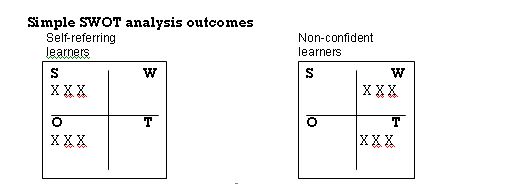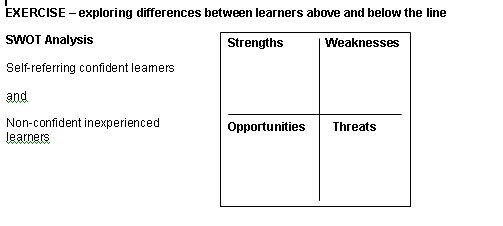Community Learning Development Resource 101 – 08
COMMUNITY LEARNING PROJECT DEVELOPMENT – WORKING ‘ABOVE AND BELOW THE LINE’
Summary
(Notes from a pilot workshop with a voluntary sector project team)
Working above the line means recruiting learners in ways within communities, which reach and work effectively with traditional adult learners.
Working below the line means targeting non-traditional adult learners, who have proved hard-to-reach through traditional methods. Developing ways of working, which will encourage and enable them to take up learning opportunities.
A challenge for the community learning work is that we can work successfully below the line, know when we are successful and understand why we are successful.

Why do we think that Community Learning and Widening Participation projects might work above the line ?
- Widening participation may be simply seen as gaining new or more learners from wherever – no need to work below the line.
- To get some successful outcomes for the work – it may be essential to have early success in terms of numbers to meet funding targets – working above the line is easier and more productive.
- To build the work presence and to establish a profile within a local area and with other partners.
- To build experience and to develop skills and practice
- To get below the line via the use of soft target learners as intermediaries, advocates, enablers, ambassadors or brokers.
Why work ‘below the line’?
- Having a mission underpinned by values of equality of opportunity, inclusion and a concern to close the learning gap.
- Having a target identified – a target community or neighbourhood.
- Having the funding and resources, which prompt allow for working below the line.
- Driven by high or misinformed expectations, that working below the line will easily yield numbers of learners from a largely untapped market.
PROMPTS FOR REFLECTION AND DISCUSSION
- Is the line a floor or a ceiling?
- Is it a barrier for the Project?
- Is it a barrier for those below the line?
Some criteria to consider within the SWOT exercise:
- Their expectations of formal learning experiences?
- Post 19 formal learning experience?
- Confidence as a learner?
- Self-perception as a learner/person?
- Experience of joining a learning group?
- Perception of a learning challenge?
- Feelings about the chance of a learning experience?
- Feelings about assessment?
- Motivation and interest?
- Giving space and time to learning?
- Feelings of others about learning – partner, family?
- OTHERS ……?

The Project is concerned to engage in Signposting ‘below the line’
- Are the demands on time and project resource directly proportional to the length of the learning journey to be travelled by the individual learner?
- Does Signposting below the line become support for capacity building?
ADVICE WORKER QUOTE:
‘If they are not ready to come into the Job Centre on a Wednesday afternoon, I’m not interested
PROMPTS FOR REFLECTION AND DISCUSSION
How do we penetrate below the line:
- spend time on building a presence and being available in the market-place below the line?
or
- spend time on building working relationships/ partnerships for referrals with workers/agencies already working below the line?
- or both?
Who is out there and what can they do for us – who do we need co-working relationships with, that are fit for purpose and are of mutual benefit – above and below the line?
How do we recognise that an individual has travelled a learning journey that lifts them ‘above the line’?
- Where is the Project on the community /service provider profile?
- Who does the Project need to work with and what’s the nature and purpose of the relationship?
